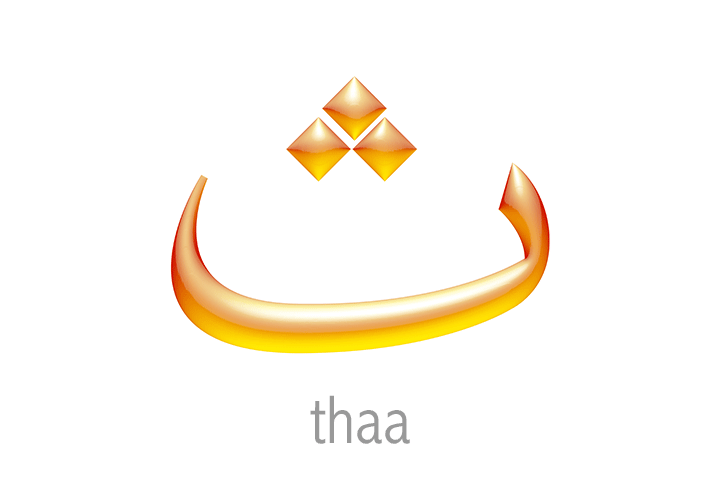Are you starting your journey to learn Arabic? The letter thaa (ث) is one of the first letters you will learn, and it is the third letter of the Arabic alphabet! Don’t worry, learning how to pronounce and write it is easier than you think. Let’s explore everything you need to know about the letter thaa (ث).
How to Pronounce Thaa’ “ث”
The pronunciation of the letter thaa is a soft, dental fricative sound, similar to the “th” in English words like “think,” “three,” or “thin.” It is not like the “th” in “this” or “that.” To pronounce it correctly, gently place the tip of your tongue between your upper and lower front teeth and blow a little air out. In the International Phonetic Alphabet (IPA), this sound is represented by /θ/.
Common Mistake: Many learners tend to pronounce thaa (ث) as a regular “t” or “s” sound. It’s important to practice placing your tongue between your teeth to make the correct, distinct sound.
Writing Thaa’ & Its Different Shapes
The letter thaa (ث) is special because it shares the same basic shape as the letters baa’ (ب) and taa’ (ت), but with three dots on top.
How to Write It: Writing thaa is simple! It is a two-step process: first, draw the main curved shape from right to left, and second, add the three dots on top.
Like most letters in the Arabic alphabet, thaa (ث) changes its shape depending on its position within a word. It has four different forms:
- Isolated Form: ث
- This is how the letter appears when it is not connected to any other letter. For example, in the number ثلاثة (thalatha – three).
- Initial Form: ثـ
- Used at the beginning of a word, connecting to the letter that follows it. For example, in the word ثوب (thawb – dress).
- The middle Thaa’ “ث” (Medial Form): ـثـ
- Used in the middle of a word, connecting to letters on both sides. For example, in the word مثال (mithal – example).
- The terminal Thaa’ “ث” (Final Form): ـث
- Used at the end of a word, connecting to the letter before it. For example, in the word حديث (hadith – conversation).
Examples of Words with Thaa’ “ث”
Let’s look at some more examples to see how the letter thaa (ث) is used in different words.
- Snow – ثَلج (thalj)
- Garlic – ثُوم (thum)
- Fruits – ثِمار (thimar)
- Search – بَحْث (Bahth)
- Furniture – أَثَاث (Athath)
- Triangle – مُثَلَّث (Muthallath)
- Proverb – مَثَل (Mathal)
- A lot – كَثِير (Katheer)
- Trace – أَثَر (Athar)
- Conversation – حَديث (Hadith)
Simple Phrases with Thaa’
Using words in simple phrases helps you understand their meaning and usage in context.
- Three books – ثلاثة كتب (Thalatha kutub)
- This is a good conversation – هذا حديث جيد. (Hadha hadith jayyid)
- The snow is beautiful – الثلج جميل. (Al-thalj jamil)
Thaa’ with the Vowels (Harakat)
The pronunciation of thaa (ث) changes slightly depending on the vowel (harakah) that is placed above or below it.
- With Fatha (ـَ): ثَ (Tha) – sounds like “tha” in thanks.
- With Damma (ـُ): ثُ (Thu) – sounds like “thu” in Thursday.
- With Kasra (ـِ): ثِ (Thi) – sounds like “thi” in think.
- With Sukoon (ـْ): ثْ (th) – This sound is more like a silent “th,” or the “th” at the end of a word, like in بَحْث (bahth – search).
- With Shaddah (ـّ): ثّ (Thth) – The sound is doubled, like in مُثَلَّث (muthallath – triangle).
Conclusion
Learning the letter thaa (ث) is a great step in your Arabic journey. Remember to practice its unique pronunciation by placing your tongue between your teeth, and familiarize yourself with its different shapes and sounds. Keep practicing, and you will master this beautiful letter in no time! For a fun and easy way to continue your learning, you can use the Kaleela app.



